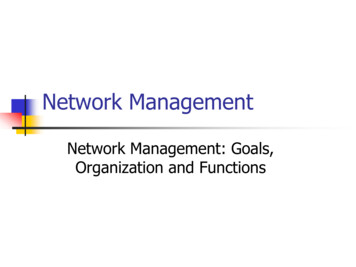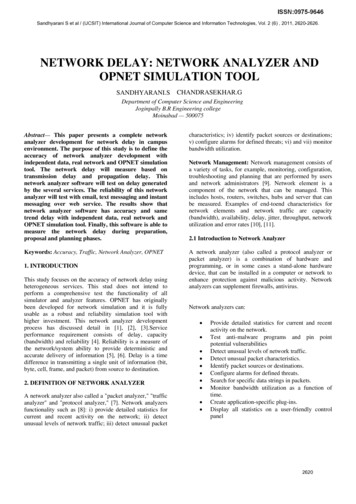
Transcription
Network ManagementNetwork Management: Goals,Organization and Functions
Telecomm/Data Network A telecommunication/Data network is composed frommany network elements (switching systems,terminals, circuits etc.) which provides certainservices for the users. The collection of suchelements forms the system resources. Heterogeneous (Platforms/Protocols) Complex (Many layered) Service Management (Fast service setup)2
View of a Telecomm/Data R-ONTADSL2 VDSL2OSP OLTVoIPIPDSLAMR-ONT6100(MSAP)GPON2x 10 GE/ OC486500ROADMGbEADSL2 tAccess NetworksOptical TransportPacketsPacketsGbE
Network ManagementSystems A network management systems are used to controlthe system and its resources by controlling its usage,access monitoring and reporting its current andhistorical status. Judgment, forecasting, decision making, analyzingdata, and make positive efforts to maintain qualityof service.
Overview: Network ManagementOAM&P(operations, administration, maintenance, and provisioning)Management PlatformCollect, organize & interpretOperational DataAdministratorWorkstationmgmt requests/repliesProvisioning- Planning- Designevent reportsAgentAgentAgentAgentObservation& ControlAgentAgentAgent
Network Management Defined As Goal OAMP (Operations, administration, maintenance and provisioning) ofNetwork and ServicesMain goal of Network Management is to ensure that the users of thenetwork receives the information technology services with the QoS thatthey expect.SLA – Formally or Informally – Operation Critical Services should be uninterrupted 24x7 and other non – critical 8x5From business administration point of view network management involvesstrategic and tactical planning of engineering, operation and maintenance ofnetwork services for current and future needs.Network Management Function Network Provisioning, operations, I&MSystems and NetworkManagementSNMP6
Network Management Operation Network Provisioning Network planning & Design; Responsibility of engineering groupKeep track of new technologies and apply based on analysis of networktraffic and performance data collected through network operations.Use Network Management ToolsNetwork Operations NOC is responsible for discharging ISO defined five OSI networkmanagement applications – fault, configuration, performance, security &Accounting Fault ManagementAccounting ManagementConfiguration ManagementPerformance ManagementSecurity ManagementSystems and NetworkManagementSNMP7
Fault Management Fault : A fault is an abnormal condition that requires management attentionfor repair whereas error is a single event. A fault is usually indicated byfailure to operate correctly or by excessive errors. For example if acommunication line is physically cut no signal will get thru so that there ispersistently high bit error rate.Fault Management Main Steps Is the process of locating faultsRelated to service failureDiscover the problemIsolate the problemFix the problem (if possible)How do we do it Trouble Ticket (I&M group)Systems and NetworkManagementSNMP8
Accounting Management Accounting Management NOC administers costs and allocates the use of the network Measure the usage of network resources and services Involves tracking individual’s utilization and grouping of network resourcesto ensure users have sufficient resources Involves granting or removing permission for access to the networkThe reason to do accounting An end user or group of users may be abusing their access privilege andburdening the network at the expense of others An end user may be making inefficient use of the network Network Managers can plan better growth of the network if user behaviouris know.Systems and NetworkManagementSNMP9
Configuration Management Config Mgmt is related to initializing the network and gracefully shutting itdown. Manage the behaviour of devices thru software. Same device couldbe used as router or end device with the help of software with set ofattributes and values.Configuration Management Configuration of network devices controls the behavior of the network. Process of finding and setting up these critical devices Three types of configurations – Static or permanent, Dynamic orcurrent & Planned NOC has displays which shows dynamic configurations of the networkand its status Shows Failure points, traffic patterns and performanceSystems and NetworkManagementSNMP10
Performance Management Performance Concerns What is the level of network utilizationIs there excessive trafficHas thruput has been reduced to unacceptable limitsAre there any bottlenecksIs response time increasingTaken care thru monitoring & controlPerformance Management Involves measuring the performance of the network hardware, software and mediaNOC gathers data and keep it upto date to perform above stated objective as well as tune thenetwork for optimum performance.Examples of measured indicators are – network traffic/overall throughput, networkavailability/percentage utilization, Error rates, Response time/delays.Traffic analysis is useful in detecting trends and future planning, performance data onavailability and delay is useful for tuning the network and increase the reliability and improvethe response time.Systems and NetworkManagementSNMP11
Security Management Security Management Is the process of controlling access to the information on the networkProvides a way to monitor access points and records information on a periodic basisProvides audit trails and sounds alarms for security breachesA security database is established and maintained by the NOC for access to network andnetwork information.Generating, distributing & storing encryption keysPassword and Access control and AuthenticationAudit logs Security recordsEnabling disabling logging services.Systems and NetworkManagementSNMP12
Overview: Network ManagementOAM&P(operations, administration, maintenance, and provisioning)Management PlatformCollect, organize & interpretOperational DataAdministratorWorkstationmgmt requests/repliesProvisioning- Planning- Designevent reportsAgentAgentAgentAgentObservation& ControlAgentAgentAgent
Network Management Standards OSI (CMIP/CMISE) International standard (ISO/OSI)Data communication networks (LAN/MAN)Deals with all seven layersMost completeObject orientedWell structured and layeredComplex and consume large resourcesInternet Model Industry standard (IETF)Originally intended for internet components (routers/switches), currentlyadopted for WANs and TelecommEasy to implement/Most widely deployedSystems and NetworkManagementSNMP14
Network Management Standards TMN IEEE LAN/MAN International standard (ITU-T)For Telecomm/based on OSI NM modelAddressed both network management and administrative aspectsIEEE standard adopted internationallyAddressed management of LANs/MANsFirst two layers of OSI model/based on OSI modelWeb-based management Web-based Enterprise ManagementJava Management Extensions (JMX)Systems and NetworkManagementSNMP15
Network Management Models OSI network model proposes following four management models Organizational Model Informational Model Structure & Organization of Management InformationISO I0165 defines SMI & MIB (Structure of management information & managementinformation database)SMI – how management information is structuredMIB – relationship and storage of informationCommunication Model Defines Components of network management system, their function & infrastructureDefines terms object, manager, agentISO I0040Mode of communication between the entities of organization modelsFunctional Model Configuration, Fault, Performance, Accounting & SecuritySystems and NetworkManagementSNMP16
Network Management Models Organizational Model Consists of Managers, Agents and Managed ObjectsMDBTwo-tier & Three-tier systemsMoMThree-tier EMS systemsNMS systemsSystems and NetworkManagementSNMP17
Network Management Models Information Model Structure & Storage of Information, e.g. ISBN – “ISBN”, “Chapter”,”Figure”Specifies the information base to describe managed objects & theirrelationshipSMI – Syntax & Semantics of management informationMIB – storage of SMI data (used by both manager & agent)MIB v/s MDB, i.e. meta-data v/s real dataExample data of MIB Network elements : hubs, bridges, routers, transmission facilitiesSoftware Processes : programs, algorithms, protocols, databasesAdministrative information : contact person, account numbersSystems and NetworkManagementSNMP18
Management Information Trees MIT Managed objects are uniquely defined by a tree structure specified by OSI modelRoot Node and well defined nodes underneath each node at different levelsEach managed object a node in the treeContainment modelISO (1)ITU (0)ISO-ITU (2)org (3)dod(6)internet(1)Systems and NetworkManagementSNMP19
Managed Object Perspective Internet PerspectiveAccess:Access privilegeObject Type:Object ID &Descriptor(Unique ID & Name of object type)Status:Syntax:Model of objectDefinition:ImplementationRequirementsTextual description ofobjectSystems and NetworkManagementSNMP20
Managed Object Perspective ISO PerspectiveObject Class:Elliptical ObjectObject Class:Circular ObjectBehaviourOperations:PushNotify changes inattribute valuesAttributes:Attributes:ellipse, dimensionsCircle, dimensionsSystems and NetworkManagementNotification:SNMP21
Managed Object leObject typePktCounterObject ClassPacket trieve or resetvaluesDescriptionCounts no. ofpktsNotificationGeneratenotification onchangeSystems and NetworkManagementSNMP22
Network Management Models Communication Model The way information is exchanged between the systemsThree important aspects are defined here Transport medium of message exchange (transport protocol)Message format of communication (application protocol)The actual messages (commands & responses)Connectionless or Connection-oriented (TP4 over X.25 or nsport LayerSystems and NMP (IETF)CMIP (OSI)UDP/IP (IETF)OSI Layer ransport Layer23
Network Management Models Functional Model Fault ManagementConfiguration ManagementPerformance ManagementAdministration ManagementSecurity ManagementSystems and NetworkManagementSNMP24
Network Management Cost Models Response Time Evaluations Asynchronous polling Synchronous pollingtdel,i average network latency delay between the manager and ithagenttp average processing time for handling a single request/responsemessagetcomp computation time to process the collected dataFind out the overall response time for both the modesSystems and NetworkManagementSNMP25
Network Management Cost Models Bandwidth Overhead EvaluationsSreq Size of a request packetSres Size of a response packetOt transport protocol overheadP no. of polling intervalsFind out the network bandwidth overheadSystems and NetworkManagementSNMP26
Network Management Operation Network Provisioning Network planning & Design; Responsibility of engineering group Keep track of new technologies and apply based on analysis of network traffic and performance data collected through network operations. Use Network Management Tools Network Operations NOC is responsible for discharging ISO defined five OSI network










